Polymorph Selection and Derivatization in Enantiomerically Pure Medicarpin: Crystallographic and Computational Insights
Abstract
1. Introduction
2. Results and Discussion
2.1. Natural Extraction of Medicarpin and Synthesis of Derivatives
2.2. Crystallographic Characterization of Medicarpin Polymorphs 1(I) and 1(II)
2.3. Crystallographic Characterization of Medicarpin Polymorphs and Derivative 2
2.4. Analysis of the Supramolecular Motifs of Medicarpin Polymorphs and Derivative 2
2.5. Hirshfeld Surface Analysis of (+)-(6aS,11aS)-Medicarpin Polymorphs and Derivative 2
2.6. Theoretical Calculation of Crystal Lattice Energy Contributions
3. Materials and Methods
3.1. FT-IR, NMR, and MS Spectroscopic Studies
3.2. HPLC Analysis
3.3. X-Ray Diffraction Studies
3.4. Quantum Chemistry Studies
3.5. Synthetic Procedures
3.5.1. General Procedure for Synthesis of (6aS,11aS)-9-Methoxy-6a,11a-dihydro-6H-benzofuro [3,2-c]chromen-3-yl 4-nitrobenzoate (2)
3.5.2. General Procedure for Synthesis of (6aS,11aS)-9-Methoxy-6a,11a-dihydro-6H-benzofuro [3,2-c]chromen-3-yl diethylcarbamate (3)
4. Conclusions
Supplementary Materials
Author Contributions
Funding
Institutional Review Board Statement
Data Availability Statement
Acknowledgments
Conflicts of Interest
References
- Yao, C.; Zhang, S.; Wang, L.; Tao, X. Recent advances in polymorph discovery methods of organic crystals. Cryst. Growth Des. 2023, 23, 637–654. [Google Scholar] [CrossRef]
- Nangia, A. Supramolecular chemistry and crystal engineering. J. Chem. Sci. 2010, 122, 295–310. [Google Scholar] [CrossRef]
- Deesamer, S.; Chavasiri, W.; Chaichit, N.; Muangsin, N.; Kokpol, U. 9-Meth oxy-6a,11a-di methyl-6a,11a-di hydro-6H-1-benzofuro [3,2-c]chromen-3-ol from Dalbergia oliveri. Acta Crystallogr. E 2009, 65, o2387. [Google Scholar] [CrossRef] [PubMed]
- Beran, G.J.O.; Wright, S.E.; Greenwell, C.; Cruz-Cabeza, A.J. The interplay of intra- and intermolecular errors in modeling conformational polymorphs. J. Chem. Phys. 2022, 156, 104112. [Google Scholar] [CrossRef] [PubMed]
- Greenwell, C.; McKingley, J.L.; Zhang, P.; Zeng, Q.; Sun, G.; Li, B.; Wen, S.; Beran, G.J.O. Overcoming the difficulties of predicting conformational polymorph energetics in molecular crystals via correlated wavefunction methods. Chem. Sci. 2020, 11, 2200–2214. [Google Scholar] [CrossRef]
- Bannan, C.C.; Ovanesyan, G.; Darden, T.A.; Graves, A.P.; Edge, C.M.; Russo, L.; Copley, R.C.B.; Manas, E.; Skillman, A.G.; Nicholls, A.; et al. Crystal structure prediction of drug molecules in the cloud: A collaborative blind challenge study. Cryst. Growth Des. 2025, 25, 1299–1314. [Google Scholar] [CrossRef]
- Finefield, J.M.; Sherman, D.H.; Kreitman, M.; Williams, R.M. Enantiomeric natural products: Occurrence and biogenesis. Angew. Chem. Int. Ed. 2012, 51, 4802–4836. [Google Scholar] [CrossRef]
- Hernández-García, A.; Velázquez-Becerra, C.; Herrera-Bucio, R.; García-Magaña, J.J.; López-Albarrán, P.; Ambriz, E. Establishment of callus and cell suspensions cultures of Dalbergia congestiflora (Fabaceae) to (+)-medicarpin production. Asian J. Plant Sci. 2021, 20, 109–115. [Google Scholar] [CrossRef]
- Lu, C.; Du, R.; Fu, H.; Zhang, J.; Zhao, M.; Wei, Y.; Lin, W. Heterologous biosynthesis of medicarpin using engineered Saccharomyces cerevisiae. Synth. Syst. Biotechnol. 2023, 8, 749–756. [Google Scholar] [CrossRef]
- Sharma, A.; Sharma, A.; Sharma, A.; Kumar, Y.; Sharma, P.; Bhardwaj, R.; Sharma, I. Polyphenol Phytoalexins as the Determinants of Plant Disease Resistance. In Plant Phenolics in Biotic Stress Management; Springer: Singapore, 2024; pp. 243–274. [Google Scholar] [CrossRef]
- Herrera-Bucio, R.; Villanueva-Mejía, F.; Zamudio-Ojeda, A.; Guevara-Martínez, S.J.; Morales-Palacios, F.G. Analysis through molecular docking of alliodorin on the enzyme laccase and its inhibitory activity on Trametes versicolor. Rev. Bio Cienc. 2025, 12, e1861. [Google Scholar] [CrossRef]
- Martínez-Sotres, C.; López-Albarrán, P.; Cruz-de-León, J.; García-Moreno, T.; Rutiaga-Quiñones, J.G.; Vázquez-Marrufo, G.; Tamariz-Mascarúa, J.; Herrera-Bucio, R. Medicarpin, an antifungal compound identified in hexane extract of Dalbergia congestiflora Pittier heartwood. Int. Biodeterior. Biodegrad. 2012, 69, 38–40. [Google Scholar] [CrossRef]
- Guevara-Martínez, S.J.; Villanueva-Mejía, F.; Zamudio-Ojeda, A.; Herrera-Bucio, R.; Morales-Palacios, F.G. Isolation of the Antifungal Compound Alliodorin from the Heartwood of Cordia elaeagnoides A. DC. and the In Silico Analysis of the Laccase. Plants 2024, 13, 1294. [Google Scholar] [CrossRef]
- Wang, L.; Li, C.; Luo, K. Biosynthesis and metabolic engineering of isoflavonoids in model plants and crops: A review. Front. Plant Sci. 2024, 15, 1384091. [Google Scholar] [CrossRef]
- Mansoori, M.N.; Raghuvanshi, A.; Shukla, P.; Awasthi, P.; Trivedi, R.; Goel, A.; Singh, D. Medicarpin prevents arthritis in post-menopausal conditions by arresting the expansion of TH17 cells and pro-inflammatory cytokines. Int. J. Immunopharmacol. 2020, 82, 106299. [Google Scholar] [CrossRef] [PubMed]
- Yang, X.; Zhao, Y.; Hsieh, M.T.; Xin, G.; Wu, R.T.; Hsu, P.L.; Horng, L.Y.; Sung, H.C.; Cheng, C.H.; Lee, K.H. Total synthesis of (+)-medicarpin. J. Nat. Prod. 2017, 80, 3284–3288. [Google Scholar] [CrossRef]
- Li, D.; Cai, C.; Liao, Y.; Wu, Q.; Ke, H.; Guo, P.; Wang, Q.; Ding, B.; Fang, J.; Fang, S. Systems pharmacology approach uncovers the therapeutic mechanism of medicarpin against scopolamine-induced memory loss. Phytomedicine 2021, 91, 153662. [Google Scholar] [CrossRef] [PubMed]
- Shen, Z.; Yin, L.; Chang, M.; Wang, H.; Hao, M.; Liang, Y.; Guo, R.; Bi, Y.; Wang, J.; Yu, C.; et al. Medicarpin suppresses lung cancer cell growth in vitro and in vivo by inducing cell apoptosis. Acta Pharm. 2024, 74, 149–164. [Google Scholar] [CrossRef]
- Chemburkar, S.R.; Bauer, J.; Deming, K.; Spiwek, H.; Patel, K.; Morris, J.; Henry, R.; Spanton, S.; Dziki, W.; Porter, W.; et al. Dealing with the impact of ritonavir polymorphs on the late stages of bulk drug process development. Org. Process Res. Dev. 2000, 4, 413–417. [Google Scholar] [CrossRef]
- García-Zavala, S.; Guzman-Mejia, R.; Jimenez-Cruz, J.C.; Herrera-Bucio, R.; Garcia-Gutierrez, H.A.; Navarro-Santos, P.; Aviña-Verduzco, J.A. Microwave assisted synthesis, spectroscopy, crystal structure, characterization and Hirshfeld surface analysis of ureidopeptides and intermediates derived from α,α-dipeptides C-terminal glycine. J. Mol. Struct. 2024, 1301, 137358. [Google Scholar] [CrossRef]
- Jimenez-Cruz, J.C.; Guzman-Mejia, R.; Navarro-Santos, P.; Garcia-Zavala, S.; Herrera-Bucio, R.; Garcia-Gutierrez, H.A.; Aviña-Verduzco, J.A. Synthesis, crystal structure, and intrinsic reactivity descriptors of coordination complexes of [(cis-PdCl2·L-proline) L-proline] and [trans-PdCl2·(glycine-OMe)2]. J. Mol. Struct. 2023, 1294, 136354. [Google Scholar] [CrossRef]
- Spackman, P.R.; Turner, M.J.; McKinnon, J.J.; Wolff, S.K.; Grimwood, D.J.; Jayatilaka, D.; Spackman, M.A. CrystalExplorer: A program for Hirshfeld surface analysis, visualization and quantitative analysis of molecular crystals. J. Appl. Crystallogr. 2021, 54, 1006–1011. [Google Scholar] [CrossRef]
- Spackman, M.A.; Spackman, P.R.; Thomas, S.P. Beyond Hirshfeld surface analysis: Interaction energies, energy frameworks and lattice energies with CrystalExplorer. In Complementary Bonding Analysis; De Gruyter: Berlin, Germany, 2021; pp. 329–352. [Google Scholar]
- Bitchagno, G.T.M.; Nchiozem-Ngnitedem, V.A.; Melchert, D.; Fobofou, S.A. Demystifying racemic natural products in the homochiral world. Nat. Rev. Chem. 2022, 6, 806–822. [Google Scholar] [CrossRef]
- Wang, H.Y.; Li, T.; Ji, R.; Xu, F.; Liu, G.X.; Li, Y.L.; Shang, M.Y.; Cai, S.Q. Metabolites of medicarpin and their distributions in rats. Molecules 2019, 24, 1966. [Google Scholar] [CrossRef]
- Meng, Q.; Moinuddin, S.G.; Kim, S.J.; Bedgar, D.L.; Costa, M.A.; Thomas, D.G.; Young, R.P.; Smith, C.A.; Cort, J.R.; Davin, L.B.; et al. Pterocarpan synthase (PTS) structures suggest a common quinone methide–stabilizing function in dirigent proteins and proteins with dirigent-like domains. J. Biol. Chem. 2020, 295, 11584–11601. [Google Scholar] [CrossRef]
- Mskhiladze, A.; Karchkhadze, M.; Dadianidze, A.; Fanali, S.; Farkas, T.; Chankvetadze, B. Enantioseparation of chiral antimycotic drugs by HPLC with polysaccharide-based chiral columns and polar organic mobile phases with emphasis on enantiomer elution order. Chromatographia 2013, 76, 1449–1458. [Google Scholar] [CrossRef]
- Wang, Z. Comprehensive Organic Name Reactions and Reagents; John Wiley & Sons, Inc.: Hoboken, NJ, USA, 2009; pp. 2536–2539. [Google Scholar]
- Magosso, M.; Berg, M.V.D.; Schaaf, J.V.D. Kinetic study and modeling of the Schotten–Baumann synthesis of peroxyesters using phase-transfer catalysts in a capillary microreactor. React. Chem. Eng. 2021, 6, 1574–1590. [Google Scholar] [CrossRef]
- Deng, Y.; Wang, M.; Zhuang, Y.; Liu, S.; Huang, W.; Zhao, Q. Circularly polarized luminescence from organic micro-/nano-structures. Light Sci. Appl. 2021, 10, 76. [Google Scholar] [CrossRef] [PubMed]
- Nowak-Król, A.; Geppert, P.T.; Naveen, K.R. Boron-containing helicenes as new generation of chiral materials: Opportunities and challenges of leaving the flatland. Chem. Sci. 2024, 15, 7408–7440. [Google Scholar] [CrossRef]
- Horowitz, S.; Trievel, R.C. Carbon-oxygen hydrogen bonding in biological structure and function. J. Biol. Chem. 2012, 287, 41576–41582. [Google Scholar] [CrossRef]
- Zhang, F.; Wang, L.; Fang, W.; Liu, Y.; Shi, P.; Liang, P.; Gao, Z.; Bao, Y. Understanding the role of solvent polarity in the molecular self-assembly process of etoricoxib solvates. Cryst. Growth Des. 2020, 20, 3650–3662. [Google Scholar] [CrossRef]
- Zolotarev, P.N.; Nekrasova, N.A. On the influence of solvent properties on the structural characteristics of molecular crystal polymorphs. Cryst. Growth Des. 2020, 20, 7152–7162. [Google Scholar] [CrossRef]
- Nogueira, B.A.; Castiglioni, C.; Fausto, R. Color polymorphism in organic crystals. Commun. Chem. 2020, 3, 34. [Google Scholar] [CrossRef]
- Ionescu, A.R.; Bérces, A.; Zgierski, M.Z.; Whitfield, D.M.; Nukada, T. Conformational Pathways of Saturated Six-Membered Rings. A Static and Dynamical Density Functional Study. J. Phys. Chem. A 2005, 109, 8096–8105. [Google Scholar] [CrossRef]
- Bernstein, J. Polymorphism in Molecular Crystals; International Union of Crystal: Chester, UK, 2020; Volume 30. [Google Scholar]
- Tang, S.K.; Davey, R.J.; Sacchi, P.; Cruz-Cabeza, A.J. Can molecular flexibility control crystallization? The case of para substituted benzoic acids. Chem. Sci. 2021, 12, 993–1000. [Google Scholar] [CrossRef]
- Threlfall, T.L. Structural and thermodynamic explanations of Ostwald’s rule. Org. Process Res. Dev. 2003, 7, 1017–1027. [Google Scholar] [CrossRef]
- Desiraju, G.R. The Design of Organic Solids. In Crystal Engineering; Elsevier: Amsterdam, The Netherlands, 2007. [Google Scholar]
- Bøjesen, E.D.; Iversen, B.B. The chemistry of nucleation. CrystEngComm 2016, 18, 8332–8353. [Google Scholar] [CrossRef]
- Huth, L.S.C.n.; Threlfall, T.L.; Hughes, D.S. Aspects of Isostructurality and Polymorphism in a Diverse Group of Monosubstituted Acetanilides. Cryst. Growth Des. 2024, 24, 2552–2566. [Google Scholar] [CrossRef]
- Cruz-Cabeza, A.J.; Feeder, N.; Davey, R.J. Open questions in organic crystal polymorphism. Commun. Chem. 2020, 3, 142. [Google Scholar] [CrossRef] [PubMed]
- Ballester, P.; Alessandro, S. Supramolecular Aspects in Catalysis. Front. Chem. 2019, 7, 174. [Google Scholar] [CrossRef]
- Webber, M.J.; Langer, R. Drug delivery by supramolecular design. Chem. Soc. Rev. 2017, 46, 6600–6620. [Google Scholar] [CrossRef] [PubMed]
- Yao, X.; Li, T.; Wang, J.; Ma, X.; Tian, H. Recent progress in photoswitchable supramolecular self-assembling systems. Adv. Opt. Mater. 2016, 4, 1322–1349. [Google Scholar] [CrossRef]
- Yin, Y. Responsive photonic crystals. Angew. Chem. Int. Ed. 2011, 50, 1492–1522. [Google Scholar] [CrossRef]
- Gong, N.; Zhang, G.; Jin, G.; Du, G.; Lu, Y. Polymorphs and versatile solvates of 7-hydroxyisoflavone. J. Pharm. Sci. 2016, 105, 1387–1397. [Google Scholar] [CrossRef]
- Mackenzie, C.F.; Spackman, P.R.; Jayatilaka, D.; Spackman, M.A. CrystalExplorer model energies and energy frameworks: Extension to metal coordination compounds, organic salts, solvates and open-shell systems. Int. Union Crystallogr. J. 2017, 4, 575–587. [Google Scholar] [CrossRef]
- Karothu, D.P.; Mahmoud, H.J.; Ahmed, E.; Ferreira, R.; Spackman, P.R.; Spackman, M.A.; Naumov, P. Global analysis of the mechanical properties of organic crystals. Angew. Chem. Int. Ed. 2022, 61, e202113988. [Google Scholar] [CrossRef] [PubMed]
- Braga, D. Crystal engineering: From promise to delivery. Chem. Commun. 2023, 59, 14052–14062. [Google Scholar] [CrossRef]
- Reutzel-Edens, S.M. Dependence of the crystal growth of solids on the intensity of size reduction on the example of various pharmaceutical agents. Curr. Opin. Drug Discov. Dev. 2006, 9, 806–815. [Google Scholar] [PubMed]
- Price, S.L.; Price, L.S. Modelling intermolecular forces for organic crystal structure prediction. In Intermolecular Forces and Clusters I; Springer: Berlin/Heidelberg, Germany, 2005; pp. 81–123. [Google Scholar] [CrossRef]
- Yan, T.; Xi, D.; Fang, Q.; Zhang, Y.; Wang, J.; Wang, X. High-pressure polymorphism in hydrogen-bonded crystals: A concise review. Crystals 2022, 12, 739. [Google Scholar] [CrossRef]
- Nangia, A.K. Supramolecular Synthons in Crystal Engineering of Pharmaceutical Properties; CRC Press: Boca Raton, FL, USA, 2024. [Google Scholar]
- Abd-Elnaiem, A.M.; Mohamed, Z.E.A.; Elshahat, S.; Almokhtar, M.; Norek, M. Recent progress in the fabrication of photonic crystals based on porous anodic materials. Energies 2023, 16, 4032. [Google Scholar] [CrossRef]
- Qin, B.; Yin, Z.; Tang, X.; Zhang, S.; Wu, Y.; Xu, J.F.; Zhang, X. Supramolecular polymer chemistry: From structural control to functional assembly. Prog. Polym. Sci. 2020, 100, 101167. [Google Scholar] [CrossRef]
- Agilent. CrysAlis PRO; Agilent Technologies Ltd.: Oxfordshire, UK, 2014. [Google Scholar]
- Bruker. APEX III; Bruker AXS Inc.: Madison, WI, USA, 2019. [Google Scholar]
- Sheldrick, G.M. A short history of SHELX. Found. Adv. 2008, 64, 112–122. [Google Scholar] [CrossRef]
- Macrae, C.F.; Edgington, P.R.; McCabe, P.; Pidcock, E.; Shields, G.P.; Taylor, R.; Towler, M.; van de Streek, J. Mercury: Visualization and analysis of crystal structures. J. Appl. Crystallogr. 2006, 39, 453–457. [Google Scholar] [CrossRef]
- Pettersen, E.F. UCSF Chimera—A visualization system for exploratory research and analysis. J. Comput. Chem. 2004, 25, 1605–1612. [Google Scholar] [CrossRef] [PubMed]
- Frisch, M.; Trucks, G.W.; Schlegel, H.B.; Scuseria, G.E.; Robb, M.A.; Cheeseman, J.R.; Fox, D.J.; Scalmani, G.; Barone, V.; Mennuci, B.; et al. Gaussian 16; Revision C.01; Gaussian, Inc.: Wallingford, CT, USA, 2016. [Google Scholar]
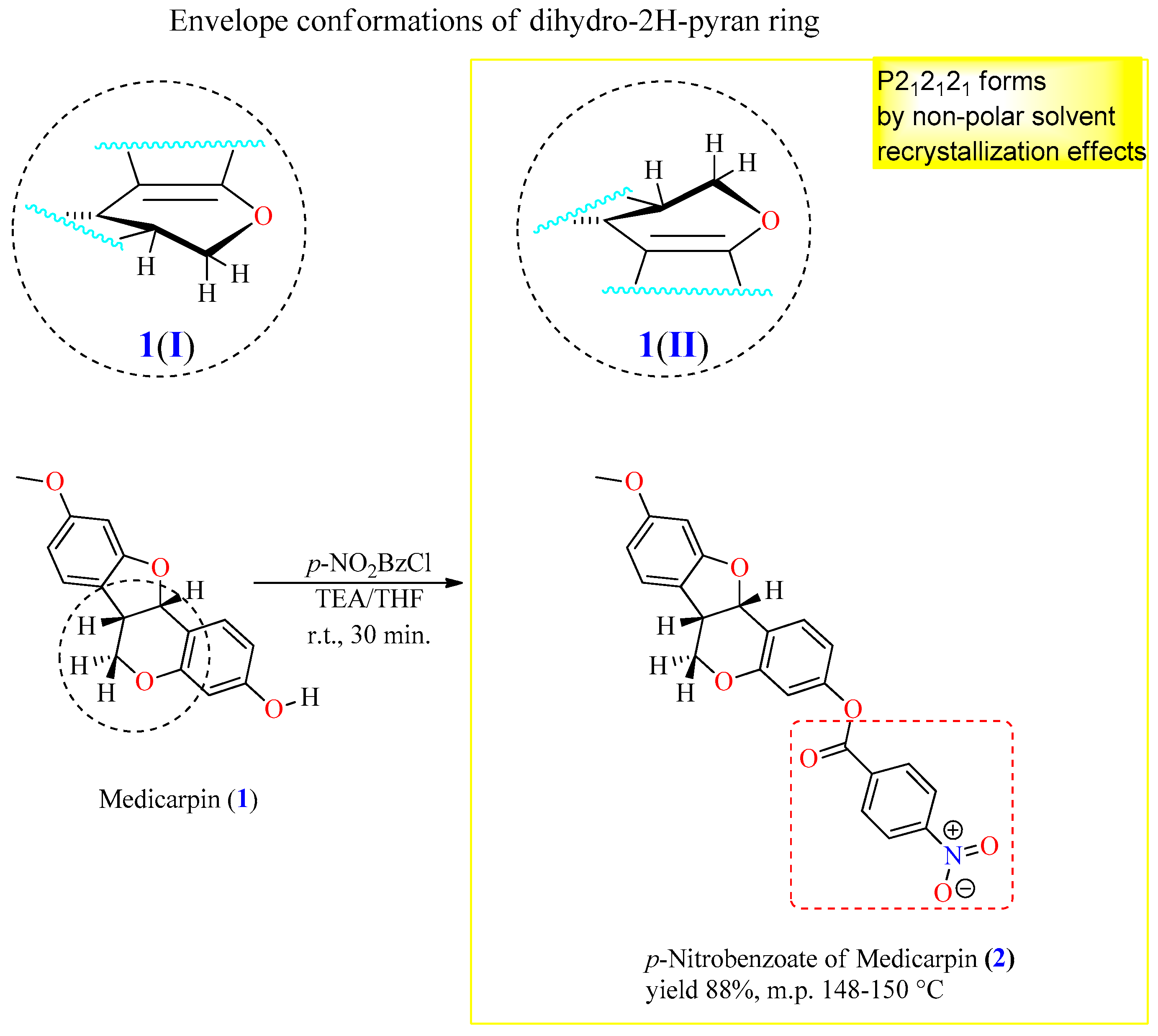
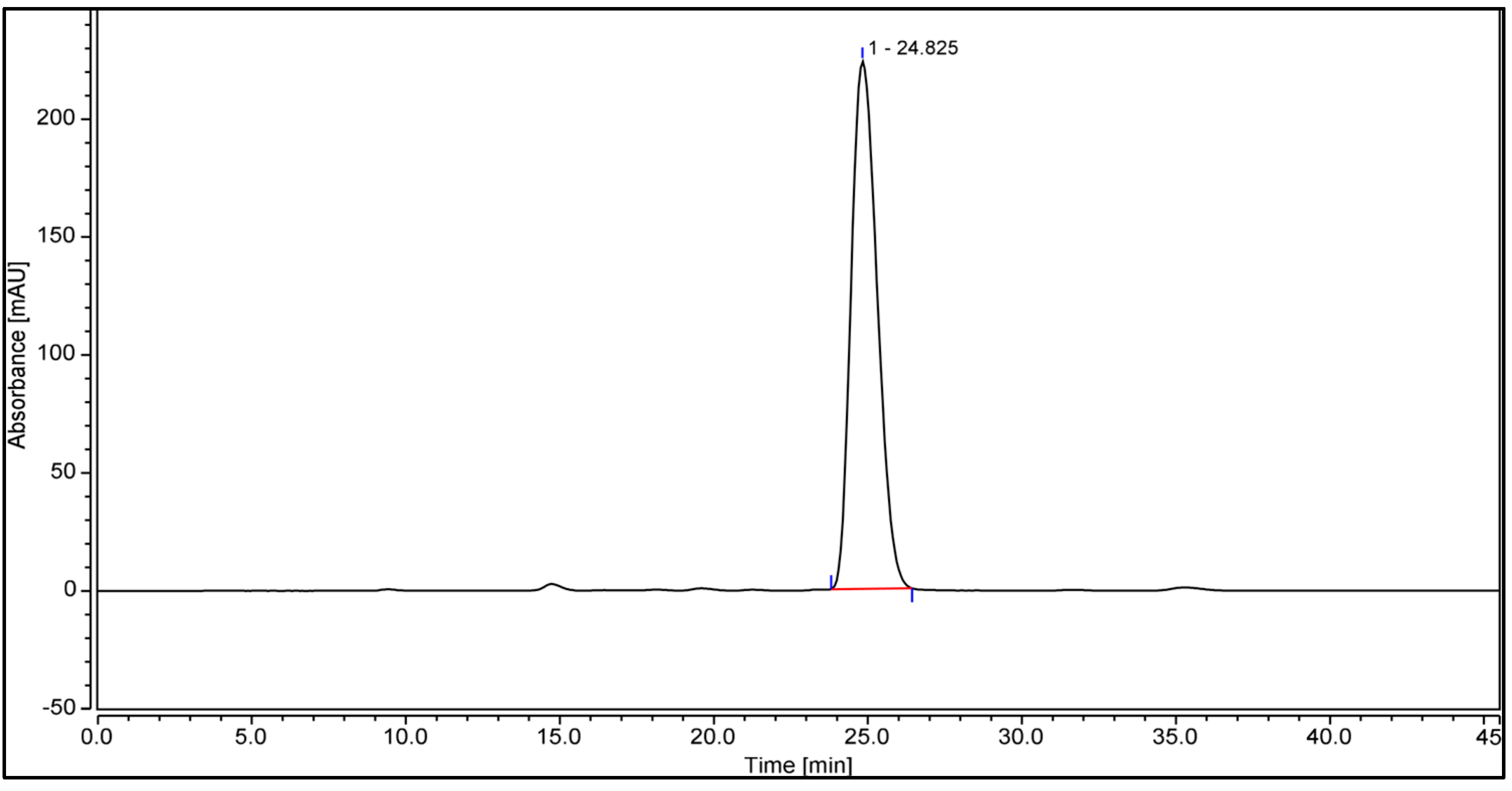
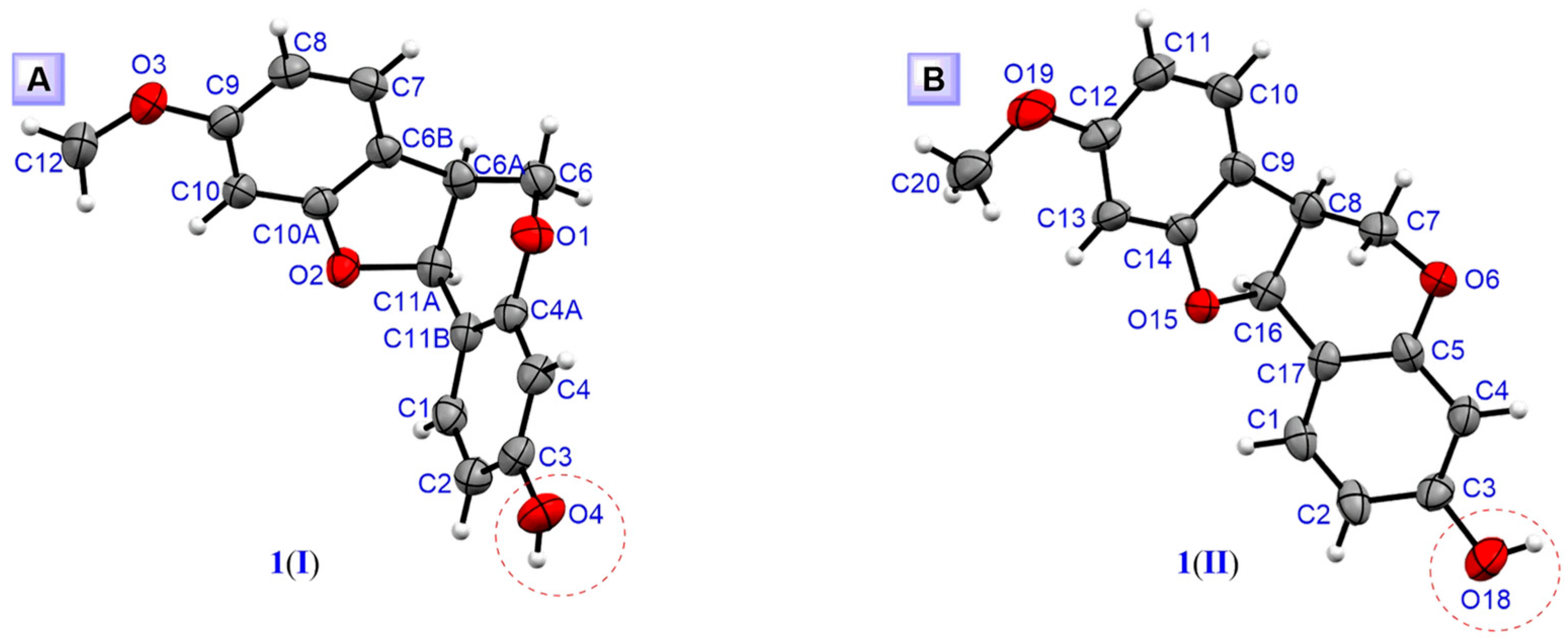
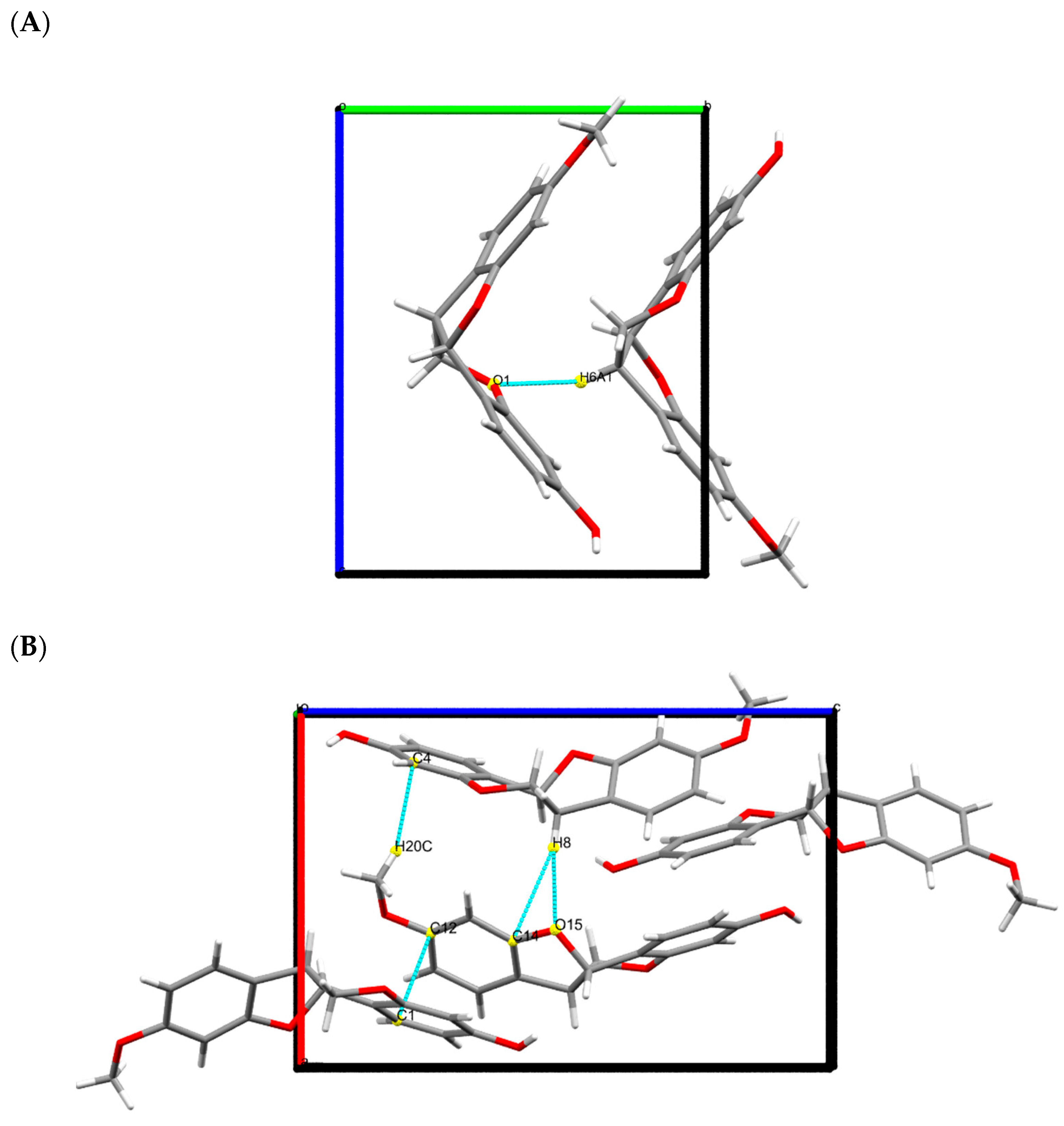
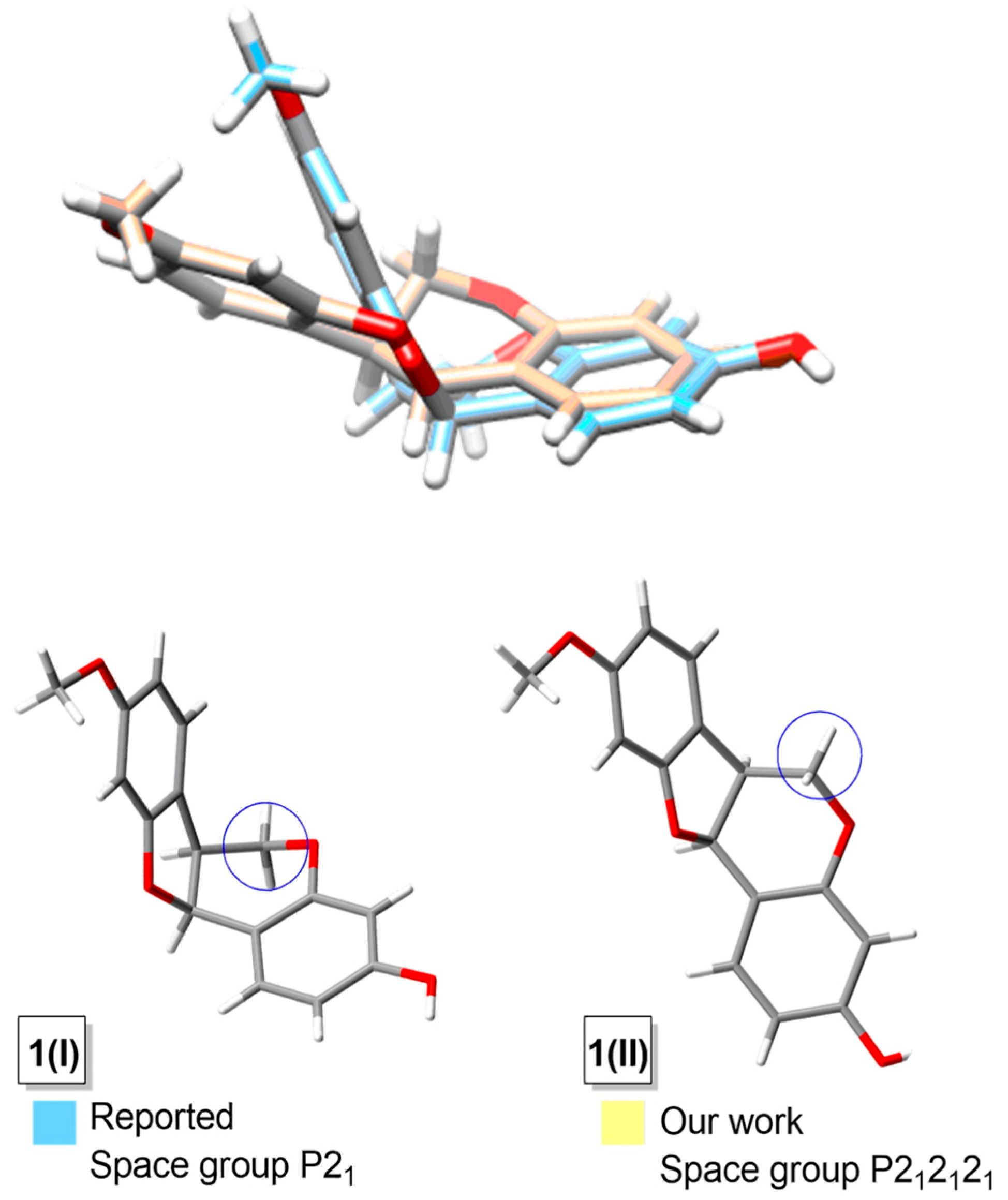
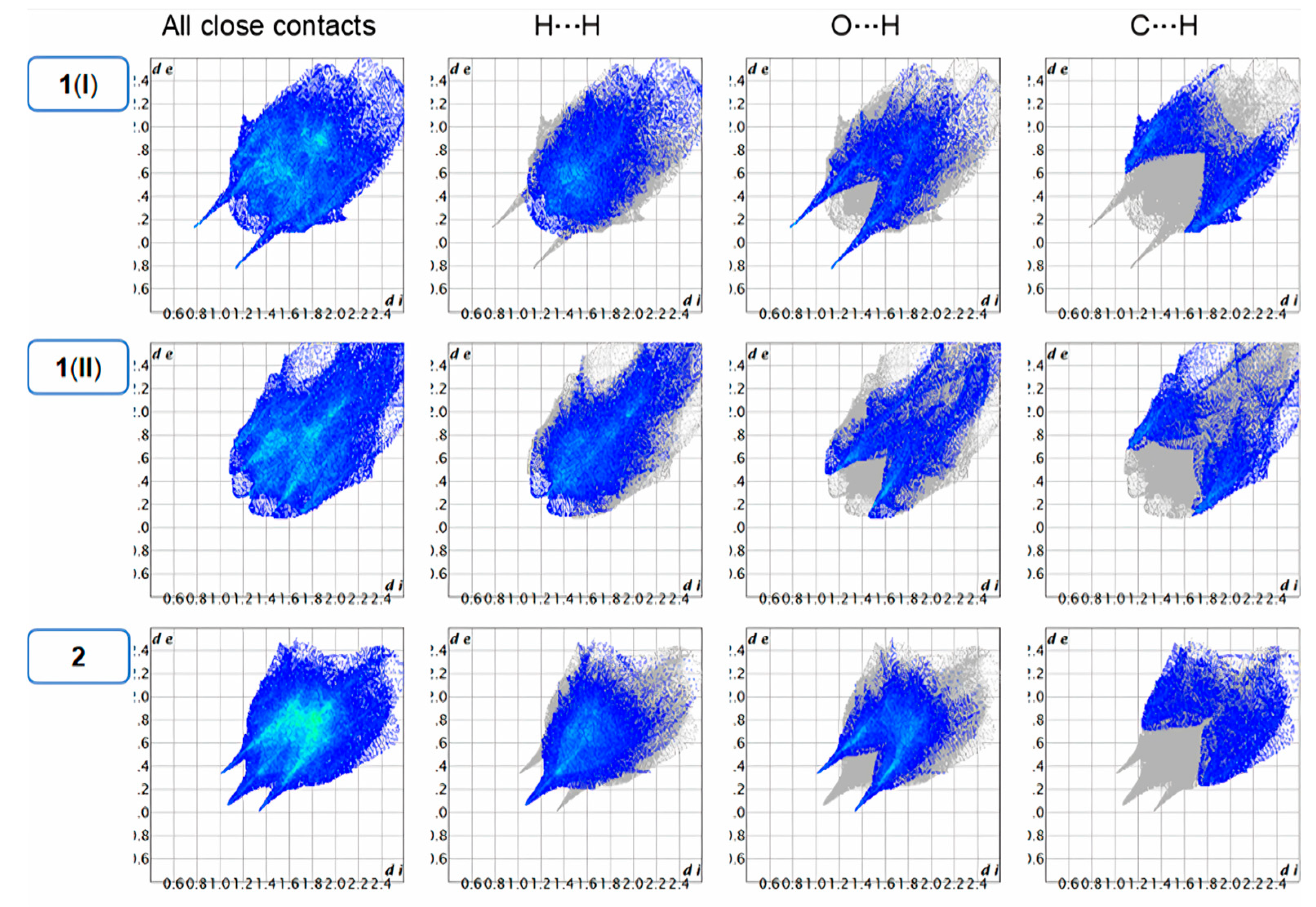
| Crystal Form | Bond | Dihedral Angle (τ) |
|---|---|---|
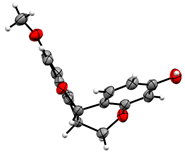 1(I) | C11A-C6A-C6-O1 [a] | 112.14° |
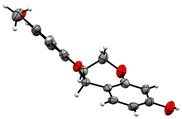 1(II) | C16-C8-C7-O6 [b] | 112.57° |
| Crystal Data | 1(I) | 1(II) | 2 |
|---|---|---|---|
| Chemical formula | C16H14O4 | C16H14O4 | C23H17NO7 |
| Mr | 270.27 | 270.27 | 419.38 |
| Crystal system | Monoclinic | Orthorhombic | Orthorhombic |
| Space group | P21 | P212121 | P212121 |
| Temperature (K) | 293 | 292 | 293 |
| a, b, c (Å) | 6.6289 (3), 8.7963 (4), 11.3150 (5) | 9.7932 (4), 9.8680 (7), 14.7311 (4) | 6.6717 (6), 13.5236 (12), 21.3751 (17) |
| Β | 99.482 (1)° | 90° | 90° |
| V (Å3) | 650.76 (5) | 1423.60 (12) | 1928.6 (3) |
| Z | 2 | 4 | 4 |
| Radiation type | Mo Kα | Mo Kα | Mo Kα |
| µ (mm−1) | 0.10 | 0.09 | 0.11 |
| Crystal size (mm) | 0.40 × 0.25 × 0.20 | 1.01 × 0.67 × 0.42 | 0.48 × 0.46 × 0.35 |
| Diffractometer | Bruker SMART | Oxford Diffraction Xcalibur S | Oxford Diffraction Xcalibur S |
| No. of measured, independent, and observed [I > 2σ(I)] reflections | 4783, 3198, 1949 | 7817, 3975, 3234 | 11,708, 6160, 3770 |
| Rint | 0.013 | 0.020 | 0.029 |
| (sin θ/λ)max (Å−1) | 0.712 | 0.755 | 0.758 |
| Refinement | 1(I) | 1(II) | 2 |
| R[F2 > 2σ(F2)] wR(F2) S | 0.034, 0.093, 1.09 | 0.169 0.457 1.92 | 0.061 0.121 1.09 |
| No. of reflections | 1949 | 3975 | 6160 |
| No. of parameters | 182 | 183 | 281 |
| Compound | Synthon | 2D Diagram | 3D Diagram |
|---|---|---|---|
| 1(I) | (A) C-H···O | 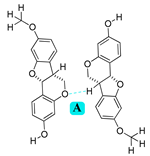 | 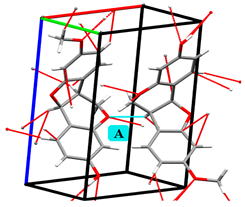 |
| 1(II) | (B) C20-H20···C4 (C) C1···C12 (D) C8-H8···C14 (E) C8-H8···O15 | 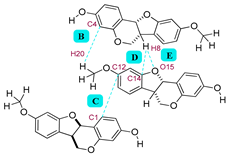 | 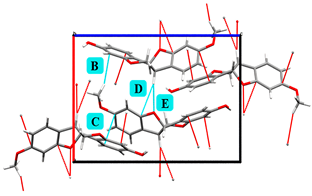 |
| 2 | (F) C31-H31···C16 (G) C1···O11 | 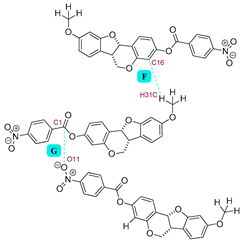 | 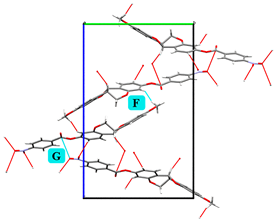 |
| Crystal Structure | Energy Contributions (kJ mol−1) | ||||||||
|---|---|---|---|---|---|---|---|---|---|
| Polymorph 1(I): | 1(I) | Symmetry | Centroid | ECou | Epol | Edisp | Erep | Etot | |
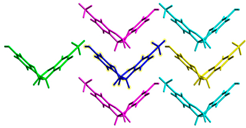 | −x,y + 1/2, −z | 5.1 | −12.6 | −3.6 | −56 | 31.2 | −45.4 | ||
| x,y,z | 11.32 | −33.4 | −7.5 | −17.4 | 38.3 | −32.3 | |||
| x,y,z | 12.14 | −2.3 | −0.6 | −6.1 | 0 | −8.1 | |||
| −x,y + 1/2, −z | 11.36 | −3.2 | −0.7 | −9 | 7.2 | −7.3 | |||
| x,y,z | 6.63 | −8.7 | −2.5 | −26.5 | 20.1 | −21.7 | |||
| −x,y + 1/2, −z | 6.09 | −10.1 | −2.6 | −34.2 | 21.6 | −29 | |||
| Σ Etot = −143.8 kJ·mol−1 | |||||||||
| Polymorph 1(II): | 1(II) | −x + 1/2, −y,z + 1/2 | 8.48 | −5.7 | −1.4 | −35 | 21.8 | −24.1 | |
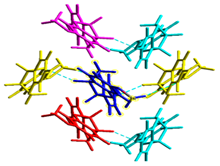 | x + 1/2, −y + 1/2, −z | 5.07 | −9.8 | −2.3 | −43.7 | 25.4 | −34.5 | ||
| −x, y + 1/2, −z + 1/2 | 8.92 | −5.7 | −1 | −19.5 | 12.4 | −16.1 | |||
| −x,y + 1/2, −z + 1/2 | 9.75 | −1.9 | −1 | −16.7 | 7.5 | −12.6 | |||
| x,y,z | 14.72 | −8.3 | −0.7 | −4.3 | 0 | −13.1 | |||
| −x + 1/2, −y,z + 1/2 | 9.8 | −0.1 | −0.7 | −9.6 | 4.1 | −6.4 | |||
| Σ Etot = −106.8 kJ·mol−1 | |||||||||
| Derivative 2: | 2 | −x,y + 1/2, −z + 1/2 | 11.77 | −6.7 | −2 | −10.8 | 8.5 | −12.7 | |
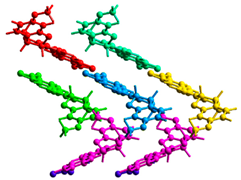 | x,y,z | 15.08 | 0.5 | −1.8 | −26 | 0 | −23.4 | ||
| x,y,z | 6.67 | −7.7 | −2.8 | −35.9 | 16.6 | −31.3 | |||
| −x,y + 1/2, −z + 1/2 | 8.75 | −2.5 | −1.6 | −42.6 | 18.8 | −29.2 | |||
| x,y,z | 13.52 | −4.8 | −1.5 | −24.6 | 0 | −27.7 | |||
| x + 1/2, −y + 1/2, −z | 8.5 | −7.7 | −2.4 | −55.8 | 25.9 | −42.5 | |||
| x + 1/2, −y + 1/2, −z | 20.27 | −4 | −0.6 | −7.4 | 0 | −11.1 | |||
| Σ Etot = −177.9 kJ·mol−1 | |||||||||
| k constants= | kECou = 1.057 | kEpol = 0.740 | kEdisp = 0.871 | kErep = 0.618 | |||||
Disclaimer/Publisher’s Note: The statements, opinions and data contained in all publications are solely those of the individual author(s) and contributor(s) and not of MDPI and/or the editor(s). MDPI and/or the editor(s) disclaim responsibility for any injury to people or property resulting from any ideas, methods, instructions or products referred to in the content. |
© 2025 by the authors. Licensee MDPI, Basel, Switzerland. This article is an open access article distributed under the terms and conditions of the Creative Commons Attribution (CC BY) license (https://creativecommons.org/licenses/by/4.0/).
Share and Cite
Guevara-Martínez, S.J.; Herrera-Bucio, R.; Pérez-Cisneros, M.A.; Velázquez-Juárez, G.; Morales-Palacios, F.G.; García-Zavala, S. Polymorph Selection and Derivatization in Enantiomerically Pure Medicarpin: Crystallographic and Computational Insights. Molecules 2025, 30, 3652. https://doi.org/10.3390/molecules30173652
Guevara-Martínez SJ, Herrera-Bucio R, Pérez-Cisneros MA, Velázquez-Juárez G, Morales-Palacios FG, García-Zavala S. Polymorph Selection and Derivatization in Enantiomerically Pure Medicarpin: Crystallographic and Computational Insights. Molecules. 2025; 30(17):3652. https://doi.org/10.3390/molecules30173652
Chicago/Turabian StyleGuevara-Martínez, Santiago José, Rafael Herrera-Bucio, Marco Antonio Pérez-Cisneros, Gilberto Velázquez-Juárez, Fredy Geovannini Morales-Palacios, and Stephanie García-Zavala. 2025. "Polymorph Selection and Derivatization in Enantiomerically Pure Medicarpin: Crystallographic and Computational Insights" Molecules 30, no. 17: 3652. https://doi.org/10.3390/molecules30173652
APA StyleGuevara-Martínez, S. J., Herrera-Bucio, R., Pérez-Cisneros, M. A., Velázquez-Juárez, G., Morales-Palacios, F. G., & García-Zavala, S. (2025). Polymorph Selection and Derivatization in Enantiomerically Pure Medicarpin: Crystallographic and Computational Insights. Molecules, 30(17), 3652. https://doi.org/10.3390/molecules30173652






